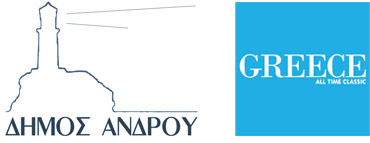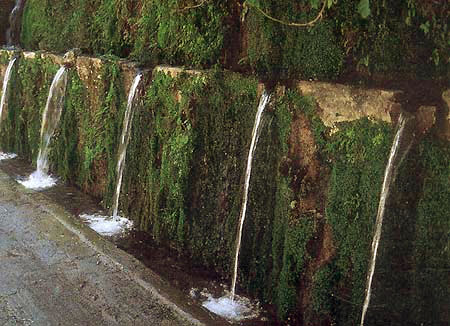Gavrio, located in the northwest of Andros, is the island’s main port.
It has regular connections from/to Rafina (1-2 daily during winter and up to 6 in the summer), as well as from/to Tinos - Mykonos. Ports in Chora and Corthi mainly host fishing boats, but also private vessels, while Batsi port operates as marina.
From the area of Gavrio one can access the north and northeast part of the island, where there are agricultural villages with developed stock farming (Fellos, Makrotantalo, Gides, Ammolochos, Varidi, Vitali) and also some of the most beautiful beaches of the island.
Heading towards the south part of the island, you can enjoy a route of exceptional beauty, passing by the busiest and best organized beaches (Agios Petros, Chrisi Ammos), as well as unique archaeological sites. You will first reach the cosmopolitan Batsi, the most touristic fishing village of Andros, where you can find hotels and rooms to let that suit every taste (and… budget), as well as restaurants, coffee houses and bars. There are also excellent beaches. One of the most enchanting areas in Batsi is Sidari.
Having to your right the islands of Kea, Gyaros, Kithnos and Syros, you continue your way towards Aprovato, where you can visit the organized archaeological site of Ypsili. If you stop at Ano Aprovato, you will get the chance to enjoy a unique view to the Aegean. Here, there is the tavern "Mpalkoni tou Aigaiou" with local cuisine.
Few kilometers to the south you come across Palaeopolis, the ancient capital of the island. In this area there are the only waterfall in Cyclades, the archaeological museum and the site of excavations that still continue. Here you can enjoy a coffee or Greek ouzo.
At Stavropeda, the island’s main road is divided in three directions: the left road leads to Chora, the middle one to the picturesque fishing village of Korthi, while the right road leads to Chalkolimionas and Apothikes beaches. From here, the trail to the archaeological settlement of Strofila with the famous rock paintings begins, while in 500 meters, on the road to Korthi and at Agia Triada, there’s the road towards ancient Zagora.
Following the road to Chora, you first encounter Pitrofos village, which is built on the slope of Mount Petalo. The vegetation is rich and the mountain’s springs provide plenty of water in the area. Before entering Pitrofos, you will come across the 12th century Byzantine church of Taxiarches, while in the village you can visit the Olive Museum, a restored old olive mill. There is also a tavern and a "hip" atmospheric bar.
As you continue towards Chora and before Messaria village, you will come across the road that leads to an exceptionally beautiful green village, Menites. The village's name is originated from “maenads”, the nymphs of god Dionysus. In the village’s square there are many water fountains that, along with the long-lived trees and the river that flows through the village, create magical scenery. The gurgling of running water, the singing of birds and the rustling of leaves compose a unique symphony. Taverns and coffee houses can also be found here.
Entering the road to Menites but before reaching the village, there is a junction that leads to Strapourgies and Ypsilou villages. Both are leafy and built on the slope of Mount Petalo, having a stunning view of Chora. There are also taverns here. The road leading to these villages ends to the main road of Chora – Apikies, while shortly before the end of it, there is a left detour that leads to Agia Marina monastery.
As you return to the main road to Chora and after passing the Menites crossroads, you reach Messaria, the old “Mesa Meria”. The 12th century Byzantine church of Taxiarches is located here, along with several tower houses and the old “Parthenagogeion” (all-female school), which is now converted into a cultural multi-purpose venue. From Messaria you can reach Chora on foot, following unique routes of cobblestone and gravel paths, alongside rivers.
Entering Messaria, there is a detour on the right of the main road that leads to Aladino, Falika, Koureli, Sasa, Zaganiari (all built on the slope of Mount Gerakones) and also to the island’s arterial leading from Stavropeda to Korthi. In Aladino village there is a significant architectural monument, the old single-arched stone bridge, which used to connect the road leading from Messaria to Falika. Cave “Foros” is located shortly after the bridge. From Falika you can take the spiral uphill road that leads to Panachrantou Monastery.
After Messaria, on the left and lower slope of Mount Petalo, is Lamyra settlement, which is -literally- covered in green. Here you will find fragrant gardens with beautiful bougainvilleas and shipowners manors of exquisite architecture. The village took its name during the 17th century when the French botanist and traveler Tournefort named it "Myra" (“Myrrh”) of Andros.
As you complete the route on the main road of the island towards Chora, you arrive at the capital of Andros. It is built on a peninsula ending in a small island where the medieval castle is situated. In front and onto the left of the castle there is Tourlitis, the only lighthouse worldwide which is built on a rock in the sea. It was built in 1887, destroyed by the Germans during World War II and rebuilt in 1994 by Goulandris family. The capital of Andros has an impressive architecture with several museums (Archaeological, Modern Art, Nautical, Folklore) and institutions (Kydonieos, Kairios Library). You can enjoy a beautiful walk in the alleys and the paved market, wander next to rivers or entertain yourself in the numerous bars, coffee places and taverns. You can swim in Neiborio and Paraporti beaches, but also do water sports in the Nautical Club. There are churches with wonderful iconostases, such as Panagia Theoskepasti (patron saint of the island) and "Agia Thalassini", a chapel built on a rock.
From Neiborio, the road next to the Nautical Club leads to Stenies and Apikia villages. After approximately one kilometer of uphill route, there is a detour on the right leading to Empros and Piso Gialia beaches, as well as to the green village of Stenies with the river and the dense vegetation. Stenies flourished in the last century due to the involvement of residents in senior and well-paid positions of merchant shipping.
As you return to the main road and head to the right, after approximately 3 km., you arrive at Apikia with the famous spring of Sariza, the water of which is considered therapeutic. There you can find “Sariza” bottled-water factory, as well as the nearby famous Pythara with its lush vegetation and crystal clear waters.
Heading north towards the top of the mountain, you find the Katakalei settlement with the breathtaking view to Aegean. From there you can take the right road that leads to Agios Nikolaos monastery.
As you continue on the main road you arrive at Vourkoti, the village with the highest altitude on the island. Locals are mainly engaged in agriculture and stock farming. From Vourkoti you can take the road leading to the famous beaches of Achla and Vori.
After Vourkoti, the main road heads northwest towards Batsi. On the way, you come across Arni (with strong farming and agriculture), Remata and Katakilo villages. All of them have lush vegetation and plenty running waters. In Katakilo there are taverns with excellent local food.
You can reach the southern part of Andros either by following the road from Stavropeda to Korthi or heading from Chora to Livadia, Vrachnou, Syneti and from there to Korthi. On the main road from "Stavropeda" you come across Zaganiari (the archaeological site of Zagora is nearby) and Kapparia, which took its name from kapari (“caper”) abounding in the area. Before Kapparia, there is the picturesque church of Agios Georgios in "Farali" and a right junction that leads to Plaka beach.
On the way to Korthi and after passing by Ano Korthi, Mousionas, Aidonia (with the traditional water fountain where women used to wash their clothes), you reach Ormos Korthiou, an ideal bay for those who love water sports and surfing. Sailing races are often take place here, like the windsurfing world championship in Mistral class. The famous beach “Tis grias to pidima” (old lady’s leap) is within walking distance. In the area of Korthi there are tower houses of the 17th and 18th century, as well as the historical school of Agia Triada (1813). You can find many hotels and rooms to let, coffee places, restaurants, bars and amazing pastry shops with excellent local products, like those of the regional women association.
Arriving at Korthi, there is a left junction towards Chora. On the way, you encounter Kochylou village, which seems to be "hanging" from the mountain, like a painting. From here you can reach Pano Kastro. Shortly after there is a crossroad leading to Panachrantou Monastery and then Syneti village with its famous “Dipotamata”, the 7 km canyon, ideal for those who love hiking. The area has unique beaches, like the secluded Lidi on the north and Syneti with its impressive stalactites next to the sea and the undersea gushing waters.
After Syneti and as you continue the journey towards Chora, you come across Vrachnou (built on the mountain slope, offers panoramic view to both Chora and the settlements situated on the opposite slope of Mount Petalo) and Livadia, a green village located in the verdant plain crossed by Megalos Potamos (“Grand River”), which empties into Paraporti.












